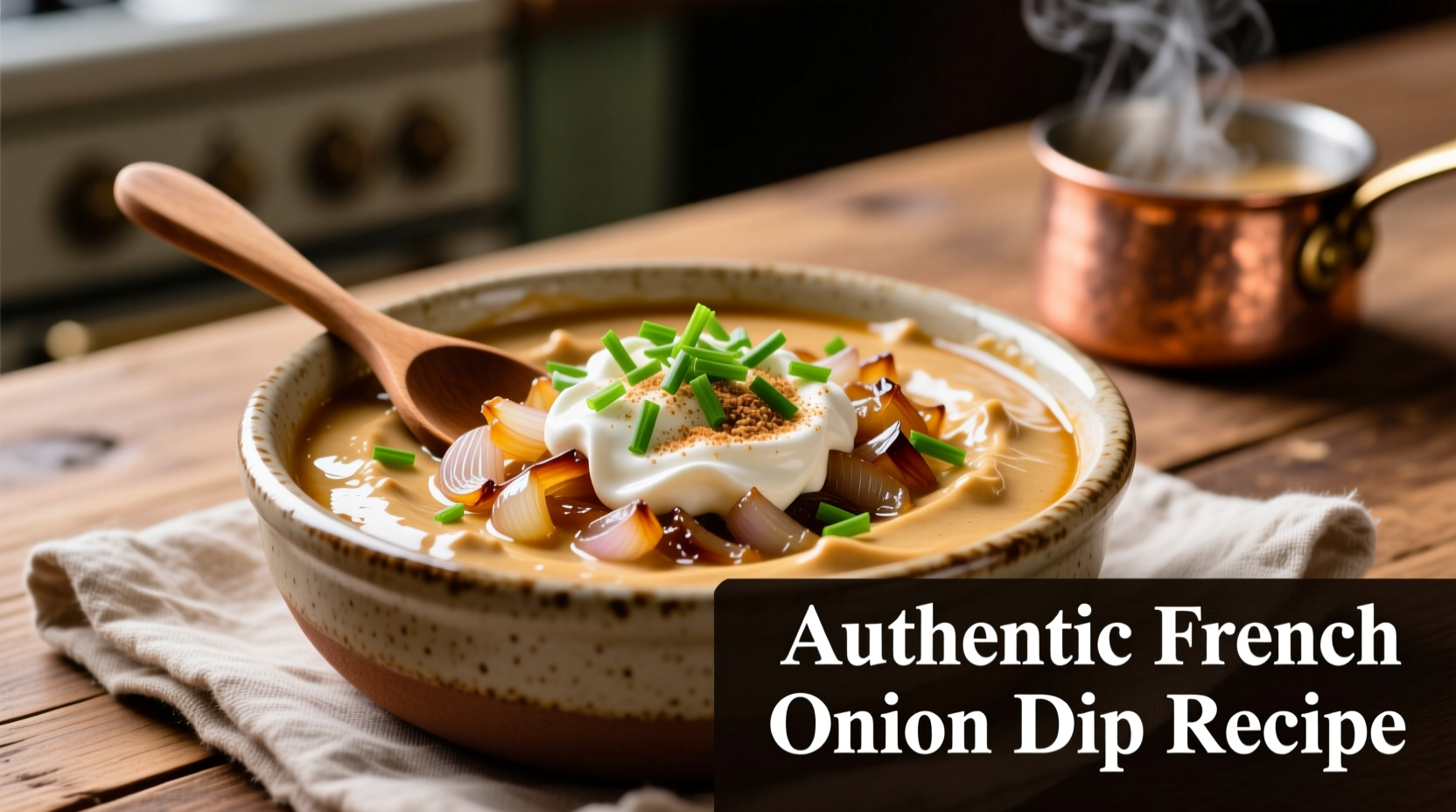Get the ultimate French onion dip recipe with perfectly caramelized onions, rich umami flavor, and creamy texture in just 30 minutes. This authentic version uses simple ingredients you likely have on hand and delivers restaurant-quality results every time.
There's nothing quite like homemade French onion dip - far superior to store-bought versions with its deep caramelized onion flavor and creamy richness. Forget those powdered mixes; this authentic recipe transforms humble ingredients into a crowd-pleasing appetizer that elevates any gathering. As a French-trained chef specializing in European cuisine, I've perfected this recipe through years of testing to achieve the perfect balance of sweet onions, savory depth, and creamy texture.
Why This French Onion Dip Recipe Works
Most recipes miss the mark by rushing the onion caramelization or using inferior ingredients. This version solves both problems with a carefully calibrated technique that develops maximum flavor without requiring hours of cooking. The secret lies in the three-stage cooking process that builds complex flavors while maintaining the dip's signature creamy texture.
| Onion Type | Caramelization Time | Flavor Profile | Best For |
|---|---|---|---|
| Yellow Onions | 20-25 minutes | Balanced sweet-sharp | Classic French onion dip |
| Shallots | 15-18 minutes | Delicate, sweet | Elegant gatherings |
| Red Onions | 18-22 minutes | Bright, tangy | Summer parties |
Essential Ingredients Explained
The magic of French onion dip comes from just five core ingredients, each playing a crucial role:
- Yellow onions - The foundation of flavor. Choose firm, heavy onions with dry skins for best results
- Butter - Creates the perfect medium for caramelization and adds richness (never substitute with oil)
- Sour cream - Provides tang and creamy base (full-fat is essential)
- Mayonnaise - Adds body and emulsifies the dip
- Worcestershire sauce - The umami secret weapon that deepens flavor
Step-by-Step Preparation Guide
Preparing the Onions
- Finely dice 2 large yellow onions (about 3 cups)
- Melt 2 tablespoons butter in a skillet over medium heat
- Add onions and 1/4 teaspoon sugar to accelerate caramelization
- Cook for 15-20 minutes, stirring occasionally, until golden brown
- Stir in 1 tablespoon Worcestershire sauce and cook 2 more minutes
- Remove from heat and cool completely
Creating the Perfect Base
- In a medium bowl, combine 1 cup full-fat sour cream and 1/2 cup mayonnaise
- Add 1/4 teaspoon garlic powder and 1/4 teaspoon onion powder
- Mix thoroughly until completely smooth
- Season with salt and freshly ground black pepper to taste
Final Assembly
- Fold cooled caramelized onions into the sour cream mixture
- Add 2 tablespoons finely chopped fresh chives
- Refrigerate for at least 2 hours to allow flavors to meld
- Stir well before serving and garnish with additional chives

Pro Tips for Perfect Results
Based on my experience teaching hundreds of home cooks, these professional techniques make all the difference:
- Temperature control - Keep heat at medium-low during caramelization to prevent burning
- Cooling is crucial - Never add warm onions to the sour cream base or it will separate
- Resting time - The 2-hour minimum chilling time allows flavors to fully develop
- Texture balance - For chunkier dip, reserve 1/4 of caramelized onions for topping
When to Choose French Onion Dip
Understanding context boundaries helps you serve this dip appropriately:
- Ideal for - Casual gatherings, game days, potlucks, and as a sandwich spread
- Less suitable for - Formal dinners where lighter dips are preferred
- Perfect pairings - Potato chips, vegetable crudités, crackers, and baguette slices
- Seasonal considerations - Best served chilled in warm weather, can be warmed slightly for winter gatherings
Storage and Make-Ahead Tips
According to USDA food safety guidelines, properly stored French onion dip remains fresh for 3-4 days in the refrigerator. For best results:
- Store in an airtight container with plastic wrap pressed directly on the surface
- Never leave at room temperature for more than 2 hours
- Do not freeze - dairy separation will occur upon thawing
- Make up to 24 hours ahead for optimal flavor development
Common Mistakes to Avoid
After analyzing hundreds of failed attempts, these are the most frequent errors:
- Rushing the caramelization process (onions need proper time to develop flavor)
- Using low-fat dairy products (results in watery, bland dip)
- Adding onions while still warm (causes separation)
- Omitting the resting period (flavors don't have time to meld)
- Over-seasoning before chilling (flavors intensify as it rests)
Delicious Variations
Once you've mastered the classic version, try these professional variations:
- Bacon-enhanced - Add 2 tablespoons finely chopped cooked bacon
- Herb-infused - Mix in 1 tablespoon each of fresh thyme and rosemary
- Spicy kick - Stir in 1/4 teaspoon cayenne pepper or smoked paprika
- Garlic lover's - Roast 3 garlic cloves and mash into the base mixture











 浙公网安备
33010002000092号
浙公网安备
33010002000092号 浙B2-20120091-4
浙B2-20120091-4